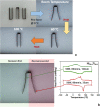Spatial Control of Functional Response in 4D-Printed Active Metallic Structures
- PMID: 28429796
- PMCID: PMC5399446
- DOI: 10.1038/srep46707
Spatial Control of Functional Response in 4D-Printed Active Metallic Structures
Abstract
We demonstrate a method to achieve local control of 3-dimensional thermal history in a metallic alloy, which resulted in designed spatial variations in its functional response. A nickel-titanium shape memory alloy part was created with multiple shape-recovery stages activated at different temperatures using the selective laser melting technique. The multi-stage transformation originates from differences in thermal history, and thus the precipitate structure, at various locations created from controlled variations in the hatch distance within the same part. This is a first example of precision location-dependent control of thermal history in alloys beyond the surface, and utilizes additive manufacturing techniques as a tool to create materials with novel functional response that is difficult to achieve through conventional methods.
Conflict of interest statement
The authors declare no competing financial interests.
Figures




References
-
- Cahill P. J. et al.. The use of a transition rod may prevent proximal junctional kyphosis in the thoracic spine after scoliosis surgery: a finite element analysis. Spine. 37, E687–E695 (2012). - PubMed
-
- Koizumi M. & Niino M. Overview of FGM research in Japan. MRS Bull. 20, 19–21 (1995).
-
- Ge Q., Qi H. J. & Dunn M. L. Active materials by four-dimension printing. Appl Phys Lett. 103, 131901 (2013).
-
- Gladman A. S. et al.. Biomimetic 4D printing. Nat Mater. 15, 413–418 (2016). - PubMed
-
- Tibbits S., McKnelly C., Olguin C., Dikovsky D. & Hirsch S. 4-D printing and universal transformation. Proceedings of the 34th Annual Conference of the Association for Computer Aided Design in Architecture 539–548 (2014).
Publication types
LinkOut - more resources
Full Text Sources
Other Literature Sources

